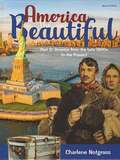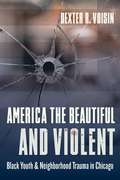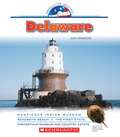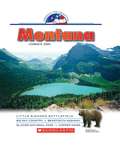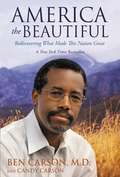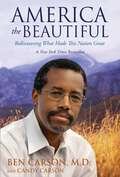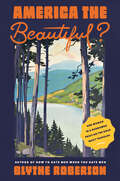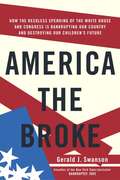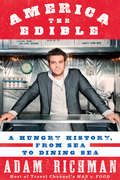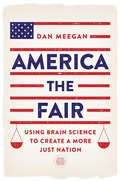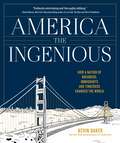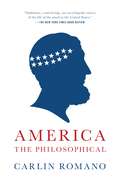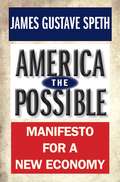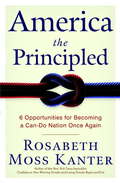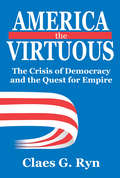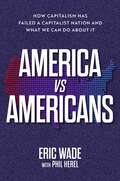- Table View
- List View
America the Beautiful Part 1: America from 1000 to 1877
by Charlene NotgrassAmerica the Beautiful, collated in a chronological order, is a package where we learn about America in thirty units. Lessons include: Our American Story; God's Wonders; An American Landmark; An American Biography; Daily Life. The author of the book ensures that readers learn about God in the making of America.
America the Beautiful Part 1: America from 1000 to 1877
by Charlene NotgrassAmerica the Beautiful by Charlene Notgrass is a one-year American history, geography, and literature course designed for students in grades 5-8. It combines the flexibility and richness of a unit study with the simplicity of a textbook-based approach to history. Daily lessons guide your child chronologically through American history, highlighting key events, people, and places. This book has 75 lessons beginning with life in America before Europeans came and continuing through the first years after the Civil War.
America the Beautiful Part 2: America from 1800s to the Present
by Charlene NotgrassThis book is a continuation of America the Beautiful Part 1 in telling the American Story.
America the Beautiful Part 2: America from the Late 1800s to the Present
by Charlene NotgrassThis book has 75 lessons beginning with the late 1800s and continuing to modern times.
America the Beautiful and Violent: Black Youth and Neighborhood Trauma in Chicago
by Dexter VoisinWidespread media narratives portray an epidemic of neighborhood violence in urban areas—often ignoring the structural explanations advanced by community organizers fighting violence and activists such as those in the Movement for Black Lives. In this book, Dexter R. Voisin provides a compelling and social-justice-oriented analysis of current trends in neighborhood violence in light of the historical and structural factors that have reproduced entrenched patterns of racial and economic inequality. <P><P>America the Beautiful and Violent is built around the powerful voices and insights of black youth in Chicago and their parents and communities. Voisin interweaves their narratives with data, research findings, and historical accounts that provide context for their experiences. He highlights the broad historical, political, economic, and racial factors that shape the construction, concentration, and narratives of violence in black neighborhoods. Voisin explores these forces and the violence they produce; the behavioral health consequences of repeated exposures to neighborhood violence; and the ways youth, families, and communities cope with such traumas. America the Beautiful and Violent offers a set of practice and policy recommendations to address the patchwork inequality that leads to concentrated violence and to support children and adolescents struggling with the precarious conditions and threat of violence in their daily lives.
America the Beautiful: Delaware
by Ann HeinrichsLook for these special features in this book: SIDEBARS, CHARTS, GRAPHS, and original MAPS expand your understanding of what's being discussed--and also make useful sources for classroom reports. FAQs answer common Frequently Asked Questions about people, places, and things. WOW FACTORS offer "Who knew?" facts to keep you thinking. TRAVEL GUIDE gives you tips on exploring the state--either in person or right from your chair! PROJECT ROOM provides fun ideas for school assignments and incredible research projects. Plus, there's a guide to primary sources--what they are and how to cite them.
America the Beautiful: Montana
by Ann HeinrichsWelcome to Montana! Mountains, rivers, and plains. A trip through time. Government by the people. Montanans at work. Getting to know Montanans. Let's explore Montana!
America the Beautiful: Montana
by R. Conrad SteinMontana is one of the nations largest states, but it is home to very few large towns or cities. Rather, it is defined by its vast wilderness areas, which range from the high peaks of the Rocky Mountains to the rolling hills and flatlands of the Great Plains. Readers will find out how Montana was settled and what role it has played in U.S. history. They will also explore the states rich culture and traditions.
America the Beautiful: North Carolina
by Ann HeinrichsNorth Carolina Is A Place Of Varied Landscapes. Its mountains are among the tallest and most rugged east of the Mississippi River, and its coastal plains are low and flat. High in the western mountains rises Mount Mitchell. At 6,684 feet (2,037 meters), it's the state's highest point. Hundreds of miles to the east, the land drops down to sea level along the Atlantic coast.
America the Beautiful: Rediscovering What Made This Nation Great
by Ben Carson Candy CarsonWhat is America becoming? Or, more importantly, what can she be if we reclaim a vision for the things that made her great in the first place? In America the Beautiful, Dr. Ben Carson helps us learn from our past in order to chart a better course for our future. From his personal ascent from inner-city poverty to international medical and humanitarian acclaim, Carson shares experiential insights that help us understand. . . what is good about America. . . where we have gone astray. . . which fundamental beliefs have guided America from her founding into preeminence among nations. Written by a man who has experienced America's best and worst firsthand, America the Beautiful is at once alarming, convicting, and inspiring. You'll gain new perspectives on our nation's origins, our Judeo-Christian heritage, our educational system, capitalism versus socialism, our moral fabric, healthcare, and much more. An incisive manifesto of the values that shaped America's past and must shape her future, America the Beautiful calls us all to use our God-given talents to improve our lives, our communities, our nation, and our world.
America the Beautiful: Rediscovering What Made This Nation Great
by Ben CarsonWhat is America becoming? Or, more importantly, what can she be if we reclaim a vision for the things that made her great in the first place? In the Zondervan ebook, America the Beautiful, Dr. Ben Carson helps us learn from our past in order to chart a better course for our future. From his personal ascent from inner-city poverty to international medical and humanitarian acclaim, Carson shares experiential insights that help us understand … what is good about America … where we have gone astray … which fundamental beliefs have guided America from her founding into preeminence among nations Written by a man who has experienced America’s best and worst firsthand, America the Beautiful is at once alarming, convicting, and inspiring. You’ll gain new perspectives on our nation’s origins, our Judeo-Christian heritage, our educational system, capitalism versus socialism, our moral fabric, healthcare, and much more. An incisive manifesto of the values that shaped America’s past and must shape her future, America the Beautiful calls us all to use our God-given talents to improve our lives, our communities, our nation, and our world.
America the Beautiful: Together We Stand (Into Reading, Read Aloud Module 6 #1)
by Katharine BatesNIMAC-sourced textbook
America the Beautiful: West Virginia
by Ann HeinrichsWest Virginia's name perfectly describes its origin. The land that is now West Virginia was once the western part of Virginia. In the 1600s, the Virginia Colony was named for Queen Elizabeth I of England. Since she never married, she was known as the Virgin Queen. When the Civil War (1861-1865) broke out, Virginia seceded, or withdrew, from the Union. But people in Virginia's western counties had a mind of their own. They didn't want to secede. Instead, they formed their own government and called their new state West Virginia.
America the Beautiful?: One Woman in a Borrowed Prius on the Road Most Traveled
by Blythe RobersonThe author of How to Date Men When You Hate Men examines Americans’ obsession with freedom, travel, and the open road in this funny, entertaining travelogue that blends the humorous observations of Bill Bryson with the piercing cultural commentary of Jia Tolentino.For writer and comedian Blythe Roberson, there are only so many Mary Oliver poems you can read about being free, and only so many times you can listen to Joni Mitchell’s travel album Hejira, before you too, are itching to take off. Canonical American travel writers have long celebrated the road trip as the epitome of freedom. But why does it seem like all those canonical travel narratives are written by white men who have no problems, who only decide to go the desert to see what having problems feels like?To fill in the literary gaps and quench her own sense of adventure, Roberson quits her day job and sets off on a Great American Road Trip to visit America’s national parks.America the Beautiful? is a hilarious trip into the mind of one of the Millennial generation’s funniest writers. Borrowing her Midwestern stepfather’s Prius, she heads west to the Loop of mega-popular parks, over to the ocean and down the Pacific Coast Highway, and, in a feat of spectacularly bad timing, through the southwestern desert in the middle of July. Along the way she meets new friends on their own personal quests, learns to cope with abstinence while missing the comforts of home, and comes to understand the limits—and possibilities—of going to nature to prove to yourself and your Instagram followers that you are, in fact, free.The result is a laugh-out-loud-while-occasionally-raging-inside travelogue, filled with meditations and many, many jokes on ecotourism, conservation, freedom, traffic, climate change, and the structural and financial inequalities that limit so many Americans’ movement. Ultimately, Roberson ponders the question: Is quitting society and going on the road about enlightenment and liberty—or is it just selfish escapism?
America the Broke
by Gerald J. Swanson“One day soon, our government will suddenly run out of cash, unable to meet its payments, leaving the United States as bankrupt as any banana republic. We are far more vulnerable than most Americans realize. . . With a debt of $7. 3 trillion, if interest rates were to hit the levels we saw 20 years ago, it would take every nickel collected in income taxes just to pay the interest on our existing debt. There would be no money left for defense, or homeland security, or education, or Social Security. This scenario is hardly fiction. That the United States of America can literally go broke is no longer a fantasy but likelihood—unless we stop the train now speeding us to Armageddon. If we do not get our financial house in order, and soon, our great nation will collapse under the weight of its financial obligations. I believe we can prevent the catastrophe. But time is short. In the final reckoning, it’s up to us to do what’s needed to save America’s future. ”—fromAmerica the BrokeThe dirty little secret that neither George W. Bush nor Congress are willing to confront—that America’s reckless spending, disastrous deficits, and exploding debt are speeding our great nation to financial ruin. Imagine a world in which you lose your job because your company goes under, your retirement money disappears, the value of your home tumbles overnight, your bank stops allowing cash withdrawals, and your ATM card is canceled. The price of groceries has risen so fast that you don’t have the money to pay for them at the check-out counter . . . and the country is bankrupt. That is exactly the future that economist Gerald J. Swanson sees America hurtling toward—unless we rein in our country’s reckless spending. InAmerica the Broke, Swanson, coauthor of the runawayNew York TimesbestsellerBankruptcy 1995, argues that the United States is on the brink of financial collapse. Thanks to George W. Bush’s two tax cuts, the White House and Congress’ escalation of domestic spending, two wars, and an economic recession, what was a $200 billion annual surplus three years ago under Bill Clinton has become a river of red ink. The White House’s official projected deficit for 2004 is $521 billion—the largest deficit in U. S. history. With a national debt spiraling upward of $7. 3 trillion, a huge trade deficit, and personal debt at an all-time high, we are standing at the edge of a financial abyss that could undermine the financial security of our families and our children’s children. “Deficits don’t matter,” claim Vice President Dick Cheney and other members of the Bush Administration. But the facts revealed inAmerica the Brokepaint an alarming picture. Next year’s projected deficit will exceed the amount all our cities spend on police, fire protection, medical care, and every other civil service in an entire year. It is more than we could save from abolishing Medicare and Medicaid completely. Therealdeficit—the deficit the government doesn’t want you to know about—including the hidden funds we “borrow” from Social Security is nearly $1trillion. Rising interest rates alone could trigger staggering payments on our skyrocketing debt, soaking up every dollar the government takes in, leaving America bankrupt. What does this mean for you and me? If the dollar goes into free fall, banks could close, businesses go bankrupt, real estate values crumble, and middle-class families could lose everything they own. But there is hope. We can save ourselves—ifwe demand that our political leaders act now to eliminate the deficit and reduce the debt. In a year of deficit de
America the Edible: A Hungry History, from Sea to Dining Sea
by Adam RichmanGet ready to devour America. Adam Richman, the exuberant host of Travel Channel's Man v. Food and Man v. Food Nation, has made it his business to root out unique dining experiences from coast to coast. Now, he zeroes in on some of his top-favorite cities—from Portland, Maine, to Savannah, Georgia—to share his uproariously entertaining food travel stories, top finds, and some invaluable (and hilarious) cautionary tales. America the Edible also tells the story behind the menu, revealing the little-known reason why San Francisco's sourdough bread couldn't exist without San Francisco's fog; why Cleveland just might have some of the country's best Asian cuisine; and how to eat like a native on the Hawaiian island of Oahu. Unflaggingly funny, curious, and, of course, hungry, Richman captures the spectacular melting pot of American cuisine as only a true foodie and insatiable storyteller can.
America the Fair: Using Brain Science to Create a More Just Nation
by Dan MeeganWhat makes a person liberal or conservative? Why does the Democratic Party scare off so many possible supporters? When does our "injustice trigger" get pulled, and how can fairness overcome our human need to look for a zero-sum outcome to our political battles?Tapping into a pop culture zeitgeist linking Bugs Bunny, Taylor Swift, and John Belushi; through popular science and the human brain; to our political predilections, arguments, and distrusts, Daniel Meegan suggests that fairness and equality are key elements missing in today's society. Having crossed the border to take up residency in Canada, Meegan, an American citizen, has seen first-hand how people enjoy as rights what Americans view as privileges. Fascinated with this tension, he suggests that American liberals are just missing the point. If progressives want to win the vote, they need to change strategy completely and champion government benefits for everyone, not just those of lower income. If everyone has access to inexpensive quality health care, open and extensive parental leave, and free postsecondary education, then everyone will be happier and society will be fair. The Left will also overcome an argument of the Right that successfully, though incongruously, appeals to the middle- and upper-middle classes: that policies that help the economically disadvantaged are inherently bad for others. Making society fair and equal, Meegan argues, would strengthen the moral and political position of the Democratic Party and place it in a position to revive American civic life. Fairness, he writes, should be selfishly enjoyed by everyone.
America the Ingenious: How a Nation of Dreamers, Immigrants, and Tinkerers Changed the World
by Kevin Baker“Among the many rewards of America the Ingenious, Kevin Baker’s survey of Yankee know-how, is stumbling on its buried nuggets. . . . Baker examines a wide range of the achievements that have made, and still make, America great again—and again.” —The Wall Street Journal All made in America: The skyscraper and subway car. The telephone and telegraph. The safety elevator and safety pin. Plus the microprocessor, amusement park, MRI, supermarket, Pennsylvania rifle, and Tennessee Valley Authority. Not to mention the city of Chicago or jazz or that magnificent Golden Gate Bridge. What is it about America that makes it a nation of inventors, tinkerers, researchers, and adventurers—obsessive pursuers of the never-before-created? And, equally, what is it that makes America such a fertile place to explore, discover, and launch the next big thing? In America the Ingenious, bestselling author Kevin Baker brings his gift of storytelling and eye for historical detail to the grand, and grandly entertaining, tale of American innovation. Here are the Edisons and Bells and Carnegies, and the stories of how they followed their passions and changed our world. And also the less celebrated, like Jacob Youphes and Loeb Strauss, two Jewish immigrants from Germany who transformed the way at least half the world now dresses (hint: Levi Strauss). And Leo Fender, who couldn’t play a note of music, midwifing rock ’n’ roll through his solid-body electric guitar and amplifier. And the many women who weren’t legally recognized as inventors, but who created things to make their lives easier that we use every day—like Josephine Cochran, inventor of the dishwasher, or Marion O’Brien Donovan, who invented a waterproof diaper cover. Or a guy with the improbable name of Philo Farnsworth, who, with his invention of television, upended communication as significantly as Gutenberg did. At a time when America struggles with different visions of what it wants to be, America the Ingenious shows the extraordinary power of what works: how immigration leads to innovation, what a strong government and strong public education mean to a climate of positive practical change, and why taking the long view instead of looking for short-term gain pays off many times over, not only for investors and inventors, but for the rest of us whose lives are made better by the new. America and its nation of immigrants have excelled at taking ideas from anywhere and transforming them into the startling, often unexpectedly beautiful creations that have shaped our world. This is that story.
America the Philosophical
by Carlin RomanoA bold, insightful book that rejects the myth of America the Unphilosophical, arguing that America today towers as the most philosophical culture in the history of the world, an unprecedented marketplace of truth and argument that far surpasses ancient Greece or any other place one can name. With verve and keen intelligence, Carlin Romano--Pulitzer Prize finalist, award-winning book critic, and professor of philosophy--takes on the widely held belief that ours is an anti-intellectual society. Instead, while providing a richly reported overview of American thought, Romano argues that ordinary Americans see through phony philosophical justifications faster than anyone else, and that the best of our thinkers abandon artificial academic debates for fresh intellectual enterprises, such as cyberphilosophy. Along the way, Romano seeks to topple philosophy's most fiercely admired hero, Socrates, asserting that it is Isocrates, the nearly forgotten Greek philosopher who rejected certainty, whom Americans should honor as their intellectual ancestor. America the Philosophical introduces readers to a nation whose existence most still doubt: a dynamic, deeply stimulating network of people and places drawn together by shared excitement about ideas. From the annual conference of the American Philosophical Association, where scholars tack wiseguy notes addressed to Spinoza on a public bulletin board, to the eruption of philosophy blogs where participants discuss everything from pedagogy to the philosophy of science to the nature of agency and free will, Romano reveals a world where public debate and intellectual engagement never stop. And readers meet the men and women whose ideas have helped shape American life over the previous few centuries, from well-known historical figures like William James and Ralph Waldo Emerson, to modern cultural critics who deserve to be seen as thinkers (Kenneth Burke, Edward Said), to the iconoclastic African American, women, Native American, and gay mavericks (Cornel West, Susan Sontag, Anne Waters, Richard Mohr) who have broadened the boundaries of American philosophy. Smart and provocative, America the Philosophical is a rebellious tour de force that both celebrates our country's unparalleled intellectual energy and promises to bury some of our most hidebound cultural clichés.
America the Possible: Manifesto for a New Economy
by James Gustave SpethIn this third volume of his award-winning American Crisis series, James Gustave Speth makes his boldest and most ambitious contribution yet. He looks unsparingly at the sea of troubles in which the United States now finds itself, charts a course through the discouragement and despair commonly felt today, and envisions what he calls America the Possible, an attractive and plausible future that we can still realize. The book identifies a dozen features of the American political economy—the country's basic operating system—where transformative change is essential. It spells out the specific changes that are needed to move toward a new political economy—one in which the true priority is to sustain people and planet. Supported by a compelling "theory of change" that explains how system change can come to America, the book also presents a vision of political, social, and economic life in a renewed America. Speth envisions a future that will be well worth fighting for. In short, this is a book about the American future and the strong possibility that we yet have it in ourselves to use our freedom and our democracy in powerful ways to create something fine, a reborn America, for our children and grandchildren.
America the Principled
by Rosabeth Moss KanterKanter details six ways to restore America's strengths by returning to open-society principles, viewing this society as one that "invests in people and new ideas, rewards talent and hard work, values dialogue and learns from dissent, operates to high standards with transparent information, looks for common ground, sees problems as opportunities for creative change, and encourages those who are fortunate to help others. " She discusses how America needs to spread innovation and the opportunity to participate in the economic revolution of the twenty-first century, and have a new social contract based on real family values and fair and flexible workplaces attentive to families and women. She also argues for values-based capitalism and responsible companies, government as an instrument of public interest, engagement with the world and other countries, and a community of caring. Kanter (strategy, innovation, and leadership for change, Harvard Business School) has advised CEOs of large and small companies and is the author of several books. Annotation ©2008 Book News, Inc. , Portland, OR (booknews. com)
America the Virtuous: The Crisis of Democracy and the Quest for Empire
by Clase G. RynUrged on by a powerful ideological and political movement, George W. Bush committed the United States to a quest for empire. American values and principles were universal, he asserted, and should guide the transformation of the world. Claes Ryn sees this drive for virtuous empire as the triumph of forces that in the last several decades acquired decisive influence in both the American parties, the foreign policy establishment, and the media.Public intellectuals like William Bennett, Charles Krauthammer, William Kristol, Michael Novak, Richard Perle, and Norman Podhoretz argued that the United States was an exceptional nation and should bring "democracy," "freedom," and "capitalism" to countries not yet enjoying them. Ryn finds the ideology of American empire strongly reminiscent of the French Jacobinism of the eighteenth century. He describes the drive for armed world hegemony as part of a larger ideological whole that both expresses and aggravates a crisis of democracy and, more generally, of American and Western civilization. America the Virtuous sees the new Jacobinism as symptomatic of America shedding an older sense of the need for restraints on power. Checks provided by the US Constitution have been greatly weakened with the erosion of traditional moral and other culture.
America the Vulnerable
by Joel BrennerA former top-level National Security Agency insider goes behind the headlines to explore America's next great battleground: digital security. An urgent wake-up call that identifies our foes; unveils their methods; and charts the dire consequences for government, business, and individuals. Shortly after 9/11, Joel Brenner entered the inner sanctum of American espionage, first as the inspector general of the National Security Agency, then as the head of counterintelligence for the director of national intelligence. He saw at close range the battleground on which our adversaries are now attacking us-cyberspace. We are at the mercy of a new generation of spies who operate remotely from China, the Middle East, Russia, even France, among many other places. These operatives have already shown their ability to penetrate our power plants, steal our latest submarine technology, rob our banks, and invade the Pentagon's secret communications systems. Incidents like the WikiLeaks posting of secret U. S. State Department cables hint at the urgency of this problem, but they hardly reveal its extent or its danger. Our government and corporations are a "glass house," all but transparent to our adversaries. Counterfeit computer chips have found their way into our fighter aircraft; the Chinese stole a new radar system that the navy spent billions to develop; our own soldiers used intentionally corrupted thumb drives to download classified intel from laptops in Iraq. And much more. Dispatches from the corporate world are just as dire. In 2008, hackers lifted customer files from the Royal Bank of Scotland and used them to withdraw $9 million in half an hour from ATMs in the United States, Britain, and Canada. If that was a traditional heist, it would be counted as one of the largest in history. Worldwide, corporations lose on average $5 million worth of intellectual property apiece annually, and big companies lose many times that. The structure and culture of the Internet favor spies over governments and corporations, and hackers over privacy, and we've done little to alter that balance. Brenner draws on his extraordinary background to show how to right this imbalance and bring to cyberspace the freedom, accountability, and security we expect elsewhere in our lives. In America the Vulnerable, Brenner offers a chilling and revelatory appraisal of the new faces of war and espionage-virtual battles with dangerous implications for government, business, and all of us. .
America the Vulnerable: How Our Government is Failing to Protect Us Against Terrorism
by Stephen FlynnIn this powerful and urgently needed call to action, national security expert Stephen Flynn offers a startling portrait of the radical shortcomings in America's plan for homeland security. He describes a frightening scenario of what the next major terrorist attack might look like -- revealing the tragic loss of life and economic havoc it would leave in its wake, as well as the seismic political consequences it would have in Washington. Flynn also shows us how to prepare for such a disaster, outlining a bold yet practical plan for achieving security in a way that is safe and smart, effective and manageable.In this new world of heightened risk and fear, America the Vulnerable delivers a timely, forceful message that cannot be ignored.
America vs. Americans: How Capitalism Has Failed a Capitalist Nation and What We Can Do About It
by Eric WadeIn America vs. Americans, Eric Wade presents American Laborism, a revolutionary new economic system, where the greatest commodity isn&’t cash, it&’s work.Capitalism is broken. Despite its successes, capitalism gives us the largest wealth gap in American history, failing Social Security, a weak currency, and a looming threat of AI destroying our workforce. We need a new system—one built around people rather than capital. A system that values each person&’s unique contribution, ingenuity, and hard work—their labor. A system in which the greatest commodity isn&’t cash; it&’s work. And a system in which Americans at every level of society and government are working together. We need American Laborism, a revolutionary new system that presents a workable, low-tax form of capitalism for those who want it—and a dignified, healthy, happy, and fulfilled life for everyone else. Under American Laborism, if you&’re happy with the current capitalist system, great! Carry on—but you&’ll get to do it with a smaller government, fewer regulations, better-educated employees, and lower taxes. And if capitalism hasn&’t worked out as well for you, you get access to unlimited free education and training, guaranteed housing and food, and a sound asset-backed currency. Everybody wins! American Laborism isn&’t just a replacement for capitalism. It&’s an upgrade. Every American has the right to live a life of dignity, to contribute, and to ensure that their basic needs are respected by their society. American Laborism can improve the lives of every American by bringing the least among us up . . . without bringing anyone else down. It&’s time to heal our nation. It&’s time for American Laborism.

